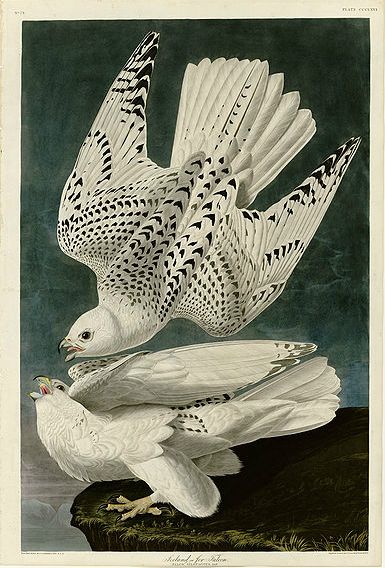
Iceland or Jer Falcon
By John James Audubon (1785-1851)
From: The Birds of America
Publication date 1827 - 1838
Falco Islandicus, Lath. Iceland or Jer Falcon - Gyr Falcon. Labrador Falcon.
Tooth-like process of the bill generally obsolete in old, festoon slight in young birds; tail from three to four inches longer than the wings. Adult white, with slate-grey sagittate spots above, the bill pale blue, the cere and feet yellow. Younger birds light grey, the feathers white on the edges; the bill and cere light blue, the feet greyish-blue. Young brownish-grey above, the feathers margined and spotted with reddish-white, the lower parts yellowish-white, longitudinally streaked with dusky.
Male, 221/2, 49. Female, 231/2, 511/4.
Breeds in the extreme north, and in Labrador. In winter, migrates southward as far as Maine.
[Text source: A Synopsis of the Birds of North America
By John James Audubon
Edinburgh: Adam And Charles Black;
London: Longman, Rees, Brown Green and Longman
1839]I recently posted on bird illustrations by Charley Harper (1992-2007), where I said:
His whimsical world captures, despite his best intentions I'm sure, some of that movement (chaos, as he calls it) of life, and especially the life of birds.John James Audubon is another American illustrator who drew a large number of birds. His world is less whimsical than Harper's, but no less bewitching. His gyrfalcons, with their dark, and perhaps cruel, eyes, still win us over with their thick, mottled, black and white feathers.
From the University of Pittsburgh:
The Donation of Audubon’s Birds of America------------------------------------------------------------------------------------------------------------------------------------------------------------
The daughters of William McCullough Darlington and Mary Carson Darlington, of Pittsburgh, Pennsylvania, donated their family library to the University of Pittsburgh in 1918 and 1925 as a memorial to their father. Birds of America was part of the collection that became the Darlington Memorial Library, established in the University’s Cathedral of Learning. According to one of Mr. Darlington's record books, he paid $400 to purchase the complete set in 1852.
Posted By: Kidist P. Asrat
------------------------------------------------------------------------------------------------------------------------------------------------------------
